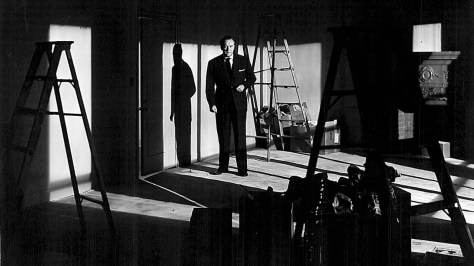
Cheryl Draper (no relation to Don; portrayed by Barbara Stanwyck) is an aging woman who never married and lives alone in an apartment. One night, she wakes and sees through her bedroom window a man in a neighboring apartment building strangling a woman.
Being the good citizen that she is, Cheryl immediately reports the crime… and no one believes her.No body is found and the police have no reason to take her word for it.
The more persistent she becomes about what she saw, the more the police become convinced she’s crazy – and the man she accused of committing murder isn’t exactly happy with her, either.
1954’s Witness to Murder was directed by Roy Rowland (Tenth Avenue Angel) with an original screenplay by producer Chester Erskine (The Belle of New York).
Witness to Murder wastes no time jumping into the story. The murder is shown right away.
The mood is somewhat similar to that of another Stanwyck film, Sorry, Wrong Number (1948). In the 1948 thriller, Stanwyck portrays Leona, a bed-stricken wife left home alone. Leona becomes paranoid when she intercepts what she thinks is a phone call about a murder.
Stanwyck’s character in Witness to Murder is undoubtedly tougher than Leona. Cheryl Draper is very stubborn, unwilling to give up her quest for the truth about the murder, even though she’s scared and everyone thinks she’s a nutcase.
Stanwyck’s performance is extremely solid, as usual. Having seen so many of her films, I’m thoroughly convinced that she can do anything.
Though Stanwyck shines, the film as a whole does have a few problems. The pace is off, often becoming very slow when it should be packed with suspense. Though there are a few unexpected turns, the story is also generally predictable.
In the beginning, the viewer is left wondering whether Cheryl actually did see the murder. The accused man does seem creepy, but it is possible that Cheryl, in a half-asleep stupor, could have imagined the whole thing. The answer of what Cheryl really saw is soon revealed, removing the element of mystery from the film.

But the story also redeems itself by bringing up interesting points about the treatment of unmarried, working, older women in the 1950s. [Spoiler alert!] Stanwyck’s character is eventually institutionalized for trying to uncover the truth, and initially the police are hesitant to believe her because they think she’s simply having menopausal hallucinations. [No more spoilers!] If Cheryl Draper was a young, married mother, would they have been quite as reluctant to believe her? They probably still would have been somewhat suspicious of her, since she’d still be a woman, but the fact that Cheryl is older and has a career certainly leads the police to treat her differently.
The highly dramatic ending, which contains the film’s best shots and some serious suspense, also brightens the viewing experience.
Witness to Murder is a pretty good thriller with a great performance from Stanwyck (as usual). It isn’t one of her best films, but it’s worth watching. The score: 3/5
This is one I really want to see but it’s been tough to track down
LikeLike
I watched it on Netflix. If you’re in the US you could watch it on there through the free trial. I’m not sure where else it’s available — I’ve never run across it on DVD.
LikeLike